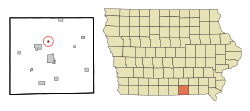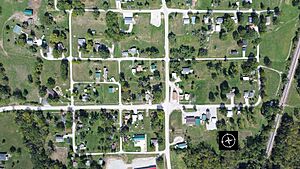Rathbun, Iowa facts for kids
Quick facts for kids
Rathbun, Iowa
|
|
|---|---|
|
City
|
|

Location of Rathbun, Iowa
|
|
| Country | USA |
| State | |
| County | Appanoose |
| Area | |
| • Total | 0.21 sq mi (0.55 km2) |
| • Land | 0.21 sq mi (0.55 km2) |
| • Water | 0.00 sq mi (0.00 km2) |
| Elevation | 906 ft (276 m) |
| Population
(2020)
|
|
| • Total | 43 |
| • Density | 200.93/sq mi (77.58/km2) |
| Time zone | UTC-6 (Central (CST)) |
| • Summer (DST) | UTC-5 (CDT) |
| ZIP Code |
52544
|
| Area code(s) | 641 |
| FIPS code | 19-65730 |
| GNIS feature ID | 2396323 |
Rathbun is a small city located in Appanoose County, Iowa, in the United States. In 2020, the city had a population of 43 people. It is a quiet place with a rich history tied to mining.
Contents
History of Rathbun
Rathbun was founded in 1892 as a town for coal miners. It officially became a city in 1897. The city was named after Charles H. Rathbun, who was an important person in the local mining industry.
In the late 1800s, the area around Walnut Creek was full of mining towns. Rathbun was one of these busy places. Other nearby towns included Jerome, Diamond, Mystic, Clarksdale, and Darby.
Coal Mining in Rathbun
The Star Coal Company from Illinois ran the Rathbun Mine. This mine used a deep shaft to reach the coal. It was working in 1895 and was known as one of the best mines in the county by 1908.
Another mine, the Darby mine, was about a mile northeast of Rathbun. It was almost out of coal by 1908. The Evans Mine, which was between Rathbun and Darbyville, had already closed by then. In 1912, a group of coal miners called United Mine Workers Local 372 had 213 members in Rathbun. This was nearly half of the town's population at that time!
Geography and Location
Rathbun is located about one mile west of where Walnut Creek meets the Chariton River. It is also about two miles south of the Rathbun Dam.
The city covers a total area of about 0.22 square miles (0.55 square kilometers). All of this area is land.
Rathbun's Climate
Rathbun has a climate known as a hot-summer humid continental climate. This means it has warm, humid summers and cold winters.
Population and People
| Historical populations | ||
|---|---|---|
| Year | Pop. | ±% |
| 1900 | 270 | — |
| 1910 | 382 | +41.5% |
| 1920 | 630 | +64.9% |
| 1930 | 299 | −52.5% |
| 1940 | 352 | +17.7% |
| 1950 | 229 | −34.9% |
| 1960 | 203 | −11.4% |
| 1970 | 113 | −44.3% |
| 1980 | 93 | −17.7% |
| 1990 | 89 | −4.3% |
| 2000 | 88 | −1.1% |
| 2010 | 89 | +1.1% |
| 2020 | 43 | −51.7% |
| Iowa Data Center Source: |
||
Rathbun's Population in 2020
According to the census from 2020, Rathbun had 43 people living there. There were 25 households and 18 families. The population density was about 200.9 people per square mile.
Most of the people in Rathbun (88.4%) were White. A small number (9.3%) were from two or more races. About 2.3% of the population was Hispanic or Latino.
In terms of age, the average age in Rathbun was 55.5 years old.
- About 11.6% of residents were under 20 years old.
- About 18.6% were between 25 and 44 years old.
- About 32.6% were between 45 and 64 years old.
- About 37.2% were 65 years or older.
The city had slightly more males (51.2%) than females (48.8%).
Education in Rathbun
Students in Rathbun attend public schools operated by the Centerville Community School District.
See also
 In Spanish: Rathbun (Iowa) para niños
In Spanish: Rathbun (Iowa) para niños


